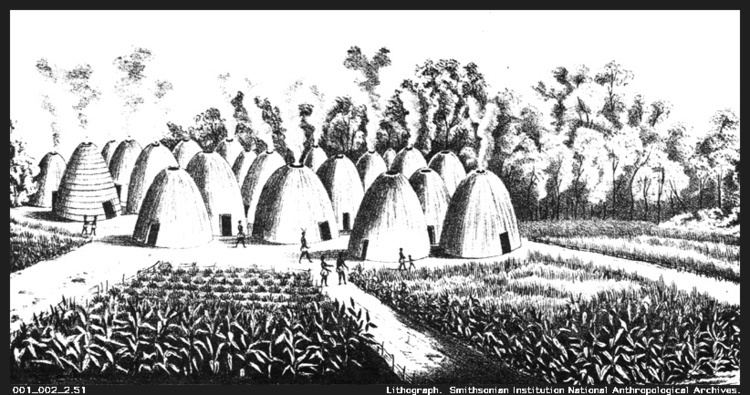 | ||
The Taovaya tribe of the Wichita people were Native Americans from Kansas, who moved south into Oklahoma and Texas in the 18th century. They spoke the Wichita language which is in the Caddoan language family. The Taovayas eventually joined the Wichita and Affiliated Tribes, headquartered in Anadarko, Oklahoma.
Contents
Early history
The people which came to be called the Wichita consisted of several tribes, including the Taovaya or Tawehash; the Tawakoni; the Iscani or Waco; and the Guichita or Wichita Proper. The Taovaya were the most important in the 18th century.
The Taovaya possibly enter written history as early as 1541 when the Spanish conquistador Francisco Vásquez de Coronado led an expedition across the Great Plains in search of a rich land called Quivira. What he found were the ancestors of the Wichita, a numerous farming and buffalo hunting people in central Kansas who possessed none of the wealth he sought. The furthest part of Quivira is believed to have been located on the Smoky Hill River near Lindsborg, Kansas. This area was called “Tabas,” similar to the later name of Taovaya. Somewhat later, from about 1630 to 1710, archaeological sites near Marion, Kansas may have been inhabited by the Taovaya.
In 1719, French explorer Claude Charles Du Tisne found two Taovaya villages of people he called "Paniouassa" near the future Neodesha, Kansas. "Pani" was a generic term the French called both Pawnee Indians and Wichita. These were probably Taovaya. That same year another French explorer, Bernard de la Harpe, visited a village, probably a few miles south of Tulsa, Oklahoma in which the inhabitants were from several Wichita tribes including the “Toayas” or Taovayas. The Toavayas were said to be the most numerous of the tribes. In their Kansas and Oklahoma homelands, however, the Wichita were under intense pressure from the Osage and Apache. In the 1720s the Taovayas and their Guichita relatives began to move south to the Red River establishing a large village on the north side of the river in Jefferson County, Oklahoma and on the south side at Spanish Fort, Texas. By the late 1750s all the Wichita tribes were living in Texas or across the Red River in Oklahoma.
The Taovayas in frontier politics
The Taovaya were allied with the French, and in 1746 the French brokered a peace between the Taovaya and other Wichita with the Comanche. The Taovaya achieved their maximum influence during the next few decades. The village at Spanish Fort was “a lively emporium where Comanches brought Apache slaves, horses and mules to trade for French packs of powder, balls, knives, and textiles and for Taovayas-grown maize, melons, pumpkins, squash, and tobacco.”
As French allies, the Taovaya ran afoul of the Spanish who had several posts and missions in southern Texas. In 1758, the Comanche, Taovaya, and other Wichita destroyed the San Saba mission of the Spanish. The next year the Spanish sent a 500 man army north to attack the Taovaya village at Spanish Fort, Texas. An Indian army met the Spaniards and routed them, capturing two cannons and killing or wounding about 50 of the Spaniards in the Battle of the Twin Villages.
The Taovaya continued to wage war against the united Spanish and Lipan Apache forces while also in the 1760s acting peacefully towards the Spanish missions among the Hasinai. This was in large part because the Taovaya assumed that the Spanish were no more centralized in government than were the speakers of Wichita languages. In December 1764 Eyasiquiche, one of the prominent leaders among the Taovaya, led an attack against Spaniards and Apaches near Mission San Lorenzo de la Santa Cruz. In this attack a Spanish soldier, Antonio Trevino, fought bravely and was taken prisoner by the Taovoya. Originally Eyasiquiche planned to adopt Trevino into the Taovaya people, but, on learning he was from Los Adaes, Esquiche decided to return Trevino there.
The French loss of their American colonies in 1763 in the French and Indian War interrupted the flow of trade goods to the Taovayas and made them more receptive to the Spanish. This process took years because the French traders remained in Louisiana, and it was not until Alejandron O'Reilly became governor that regulations were placed against the French trading with the Taovaya. In 1771 the Taovayas, the other Wichita, and the Tonkawa made a peace agreement with the Spanish, defying the Comanche. The Taovaya trading empire was diminished by the Comanche and an epidemic, probably smallpox, that struck the Wichita in 1777 and 1778, killing more than 300 of them. In 1778, the Taovaya village at Spanish Fort had 123 houses and across the Red River a Wichita town had another 37 houses. Together the two towns counted 600 men and a total population of probably around 2,500. This however, was far less than the Wichita population in the time of Coronado when they numbered several tens of thousands. In 1801 another epidemic killed a great number of them. An American visitor in 1805, Dr. John Sibley, estimated that they numbered 400 men.
The Taovaya as a coherent tribe disappeared rather suddenly. In 1811 their chief, Awahakei, died during a visit to Americans in Natchitoches, Louisiana. The tribe apparently could not select another leader and fragmented with some joining the Tawakoni on the Brazos River. The name Taovayas disappeared from history and the Americans came to collectively call them Wichita.
Taovaya culture and language was nearly the same as that of the other tribes of the Wichita.
Historical record
The 1759 Taovaya victory over Spain site received a historic marker in 1976.
The site of the 1759 Taovayo victory over Spain - 33°56′52.9434″N 97°36′58.33″W
The Taovayan Valley, a geographic region encompassing the area between the Wichita Mountains and the Red River of the South, is named after the tribe. The region was the tribe's last stronghold.
